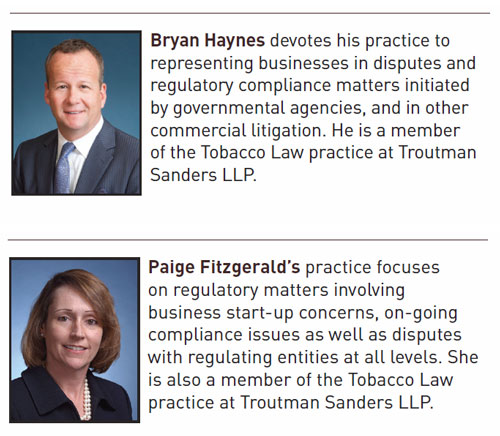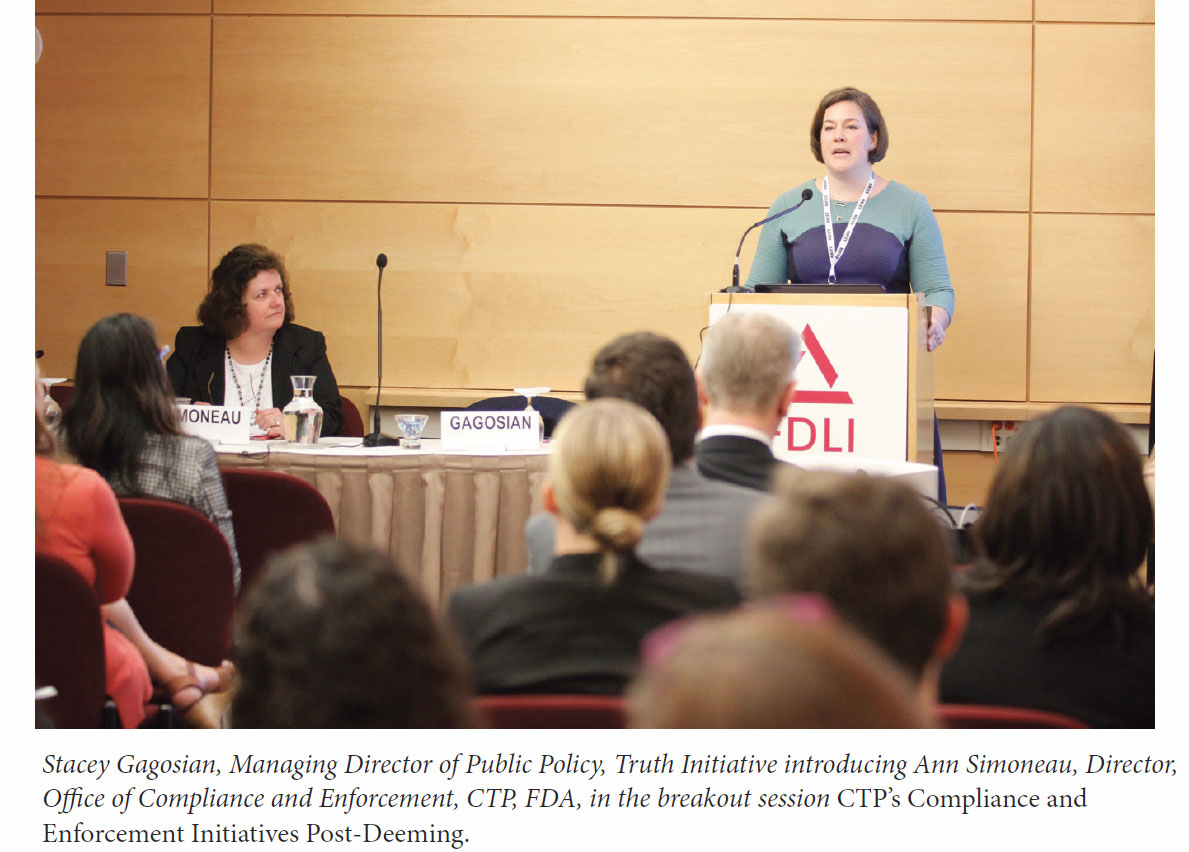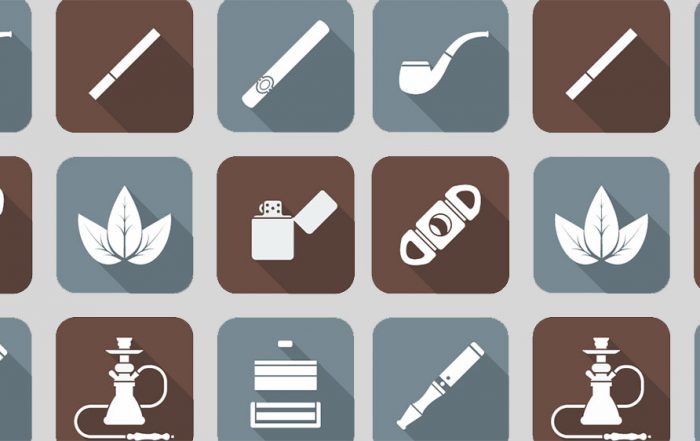
Tobacco Deeming: One Year Later
by Bryan Haynes and Paige Fitzgerald
Since the final Deeming Rule was announced at last year’s Annual Conference, we thought it would be a good time to recap the developments over the past year, and the highlights that emerged from this year’s tobacco-focused programming on current trends and hot topics.
Announced at the 2016 FDLI Annual Conference, the tobacco “Deeming Rule”1 greatly expanded FDA’s Announced at the 2016 FDLI Annual Conference, the tobacco “Deeming Rule”1 greatly expanded FDA’s authority over tobacco products. When enacted in 2009, the Tobacco Control Act (the Act) immediately covered cigarettes, cigarette tobacco, roll-your-own tobacco, and smokeless tobacco and subjected these products to specific regulation by FDA. For other kinds of tobacco products, the statute authorized FDA to issue regulations “deeming” these products to be subject to the Act.2 Once a tobacco product is so deemed, FDA could then put in place “restrictions on the sale and distribution of a tobacco product,” including age-related access restrictions and advertising and promotion restrictions, if FDA determines the restrictions are appropriate for the protection of the public health.3 The promulgation of the Deeming Rule thus extended FDA’s authority to all products that meet the statutory definition of “tobacco products,” including dissolvables not already regulated by the agency, gels, waterpipe tobacco, electronic nicotine delivery systems (ENDS) (including e-cigarettes, e-hookah, e-cigars, vape pens, advanced refillable personal vaporizers, and electronic pipes), cigars, and pipe tobacco.4
 The final Deeming Rule subjects the newly deemed tobacco products to the same requirements that regulate cigarettes, cigarette tobacco, roll-your-own tobacco, and smokeless tobacco under the Act, with respect to:
The final Deeming Rule subjects the newly deemed tobacco products to the same requirements that regulate cigarettes, cigarette tobacco, roll-your-own tobacco, and smokeless tobacco under the Act, with respect to:
(1) Enforcement action against products determined to be adulterated or misbranded (other than enforcement actions based on lack of a marketing authorization during an applicable compliance period);
(2) Required submission of ingredient listing and reporting of harmful and potentially harmful constituents (HPHCs);
(3) Required registration of tobacco product manufacturing establishments and product listing;
(4) Prohibition against sale and distribution of products with modified risk descriptors (e.g., “light,” “low,” and “mild” descriptors) and claims unless FDA issues an order authorizing their marketing;
(5) Prohibition on the distribution of free samples (same as cigarettes); and
(6) Premarket review requirements.
The Deeming Rule was effective as of August 8, 2016, and sets forth numerous compliance deadlines for newly-regulated tobacco products, with many important dates on the horizon for later in 2017 and 2018. For example, cigar warning plans were to be submitted by May 10, 2017, and ingredient listings for tobacco products were due by August 8, 2017, for non-“small scale tobacco product manufacturers.” Importantly, however, on May 1, 2017, just before this year’s FDLI Annual conference, FDA announced that it was extending and deferring all future compliance deadlines under the Deeming Rule for three months.5 FDA also provided a detailed Guidance for Industry regarding this extension and explained that “[t]he three-month extension does not apply to requirements under the final deeming rule where compliance deadlines already have passed, such as mandatory age and photo-ID checks to prevent illegal sales to minors. FDA will continue to enforce such requirements.”6
During the FDLI Keynote Address, Acting FDA Commissioner Stephen Ostroff touched on the difficulties that the industry has faced with the Deeming Rule. He explained that one day a company is working towards complying with the new requirements of the Rule—and making the necessary investments to comply—and then days later the company learns of the extension in the compliance deadlines. And, he noted that, given the new Administration’s view towards regulations in general, there is some uncertainty whether the requirements of the Deeming Rule will actually go into effect pursuant to the extended deadlines.
Several breakout sessions at this year’s conference attempted to answer industry questions about the Deeming Rule’s requirements as well as to provide an update of FDA’s enforcement thus far of the provisions that have already gone into effect. During the breakout session conducted by FDA’s Center for Tobacco Products (CTP), Mitch Zeller, the Director of CTP, provided a detailed overview of the Deeming Rule and the 90-day extension applicable to many of the Rule’s requirements. He stated that FDA has tried to assist the industry by issuing several deeming-related guidances, including ones related to premarket tobacco applications for ENDS, tobacco product master files, investigational use of deemed products, vape shop activities, cigar warning labels, and free samples. He also mentioned the recently-introduced “Hunter legislation,”7 put forward by Representative Duncan Hunter (CA), which would exempt ENDS from the Deeming Rule’s coverage and regulate such products in a completely different way.
At the CTP session, FDA’s compliance accomplishments were also discussed. During the last year, FDA conducted over 758,000 retailer inspections covering 56 states and territories; issued more than 56,900 warning letters, including ones related to cigarettes, cigarette tobacco, and roll-your-own tobacco being labeled as flavored; and initiated 11,800 civil money penalty actions for repeat violations. In addition, 43 “no tobacco sale orders” were initiated for violations of certain restrictions, including repeated sales to minors. Further, with regard to post-deeming compliance and enforcement, the audience learned that vape shop and manufacturer inspections were well underway by CTP.
At a breakout session on Friday, Ann Simoneau, Director of the CTP’s Office of Compliance and Enforcement, provided a detailed review of her office’s compliance and enforcement activities over the past year. Ms. Simoneau stressed that her office uses a three- pronged approach to ensure that the industry, including wholesalers, retailers, and manufacturers, complies with the law. First, her office focuses on compliance training, education, and outreach to ensure that industry understands the relevant requirements and how to comply with them. As part of this prong, Ms. Simoneau discussed the number of guidances that CTP has issued since May 2016 as well as the 15 webinars that it has hosted related to the final Deeming Rule. The second prong aimed at industry compliance, Ms. Simoneau explained, is surveillance, inspections, and investigations, and she noted the effort that her office has undertaken to inspect vape shops after the effective date of the Deeming Rule. As she pointed out, depending on the activities performed by a vape shop, it may be considered a retailer, a manufacturer, or both. For example, if a vape shop sells tobacco products to individuals for personal consumption—whether through a brick and mortar establishment or the internet—it may be considered a retailer. On the other hand, a vape shop may be considered a manufacturer if the shop mixes or prepares e-liquids, creates or modifies aerosolizing apparatus, repackages ENDS products, or relabels ENDS products. She also shared several photographs from her office’s inspections of vape shops to give attendees a sense of her office’s day-to-day work. She stressed that all warning letters that her office issues as a result of its inspections should be taken seriously. Ms. Simoneau noted that her office works to review all complaints from any source as part of its surveillance and investigatory function. In order to assist CTP’s efforts, it has contracted with both state agencies and private third parties to conduct inspections, so that sufficient coverage exists across the United States, including on tribal lands.

Ms. Simoneau explained that the third prong her office uses to ensure compliance is to take enforcement action. She announced that in August and September 2016, FDA issued the first 55 warning letters to retailers for selling (both in stores and online) newly-regulated tobacco products, such as e-cigarettes, e-liquids, and cigars, to minors. In addition, Ms. Simoneau noted that as of April 1, 2017, FDA has issued over 4,000 warning letters to both brick and mortar and online retailers for selling e-cigarettes, e-liquids, and cigars to minors. She also advised the attendees that problems with a tobacco product, such as an unexpected health or safety issue, may be reported to FDA’s Safety Reporting Portal. She noted that reportable problems would include, for example, products that are damaged, defective, or contaminated or products that caused fires, burns, explosions, allergic reactions, or poisonings. Ms. Simoneau concluded her presentation by outlining certain forthcoming requirements in the final Deeming Rule. She discussed the upcoming requirements that certain product packages and advertisements contain an addictiveness warning statement; the rotational cigar warning statements that will be required on product packaging and advertisements; and requirements related to ingredient listings, HPHCs and the prohibition on the introduction into interstate commerce of products that contain “light,” “low,” “mild,” or other similar descriptors in the label, labeling, or advertising of such products without a modified risk tobacco product order.
The final breakout session, entitled “Tobacco Harm Reduction: Opportunities and Regulatory Pathways to Achieve,” was moderated by Dean R. Cirotta, President and COO of EAS Consulting Group. The panelists focused on various ways the industry proposes to reduce the harm to consumers who use tobacco products. Joe Murillo, Vice President for Regulatory Affairs for Altria, began the presentation and pointed out ENDS and smokeless tobacco products present a real “tobacco harm reduction opportunity,” yet not enough consumers understand that ENDS and smokeless tobacco products present substantially lower health risks than cigarettes. He proposed several principles that FDA should consider in its regulation of newly deemed products, including presenting an opportunity for tobacco harm reduction; providing adult consumers with accurate, non-misleading information; encouraging innovation; preserving and respecting the choices of adult tobacco consumers; applying regulations equally to all manufacturers; and adhering to constitutional principles.
Swedish Match North America’s Vice President of Federal Regulatory Affairs, Jim Solyst, followed and provided an outline of Swedish Match’s efforts related to undertaking CTP’s premarket tobacco application (PMTA) and modified risk tobacco product (MRTP) pathways. Mr. Solyst provided attendees with a detailed overview of the steps Swedish Match has taken, including the types of evidence it provided to the CTP, in order to receive a PMTA order for eight of the company’s General snus products sold in the United States. Despite Swedish Match’s success in receiving the PMTA order, he explained that his company’s efforts related to having two current warning labels removed on its smokeless tobacco products, as an MRTP claim, were not successful. However, such efforts provided industry with some insight into CTP’s evaluation process for these types of claims. All panelists agreed that going forward, CTP should provide companies with sufficient room for innovation to develop tobacco products that provide opportunities to reduce harm to consumers from such use and CTP should establish regulatory pathways for such products that can be clearly understood. While many regulatory and enforcement developments have occurred following last year’s promulgation of the Deeming Rule, many questions remain. Will further extensions of the Deeming Rule occur? Will the Hunter legislation be enacted into law, exempting ENDS from coverage under the Deeming Rule? Will the new administration take other steps regarding regulation of tobacco products? What will the CTP’s enforcement priorities be during the remainder of 2017 and into 2018? The answers to these and other questions should provide more than sufficient fodder for both panelists and attendees at next year’s conference.
- 81 FR 28973 (May 10, 2016). https://www.federalregister.gov/documents/2016/05/10/2016-10685/deeming-tobacco-products-to-be-subject-to-the-federal-food-drug-and-cosmetic-act-as-amended-by-the.
- 21 USC § 387a(b).
- 21 USC 387f(d).
- 81 FR at 28976.
- FDA’s website includes a summary of these requirements along with the updated due dates.
- https://www.fda.gov/TobaccoProducts/GuidanceComplianceRegulatoryInformation/Manufacturing/default.htm.https://www.fda.gov/downloads/TobaccoProducts/Labeling/RulesRegulationsGuidance/UCM557716.pdf.
- H.R. 2194 https://www.govtrack.us/congress/bills/115/hr2194.
Update Magazine
May/June 2017








